
Painting of the coming of the True King in the world of Final Fantasy XV.
Final Fantasy XV depicts various themes involving the battle between forces of light and darkness and life and death. Final Fantasy XV can be interpreted to have allusions to Abrahamic religions, Buddhism, and Shintoism, among others. The allusions listed here are interpretative and not necessarily intended by the creators, however, the Final Fantasy series has a long history of religious and mythological allegory.
Judaeo-Christian parallels[]
Noctis[]

"Only the True King, anointed by the Crystal, can purge our star of its scourge."
Noctis is given the title of "King of Kings" of Eos, the same title used in reference to Jesus and his Second Coming. The True King is prophesied to save the world from darkness, which hearkens to the concept of the Messiah from Abrahamic religions, the one chosen to lead the world and thereby save it. The word "Messiah" itself means "anointed".
The Christian tradition has a series of associations between Christ's Cross and other, seemingly unrelated pieces of Biblical imagery. The Cross is a throne, an altar, and a marriage-bed. Noctis's sacrifice draws upon all three of these associations, as well as the Christian tradition's tension between paternal alienation and cooperation in the act of self-sacrifice through King Regis's reluctant participation in his son's death.
In the painting of the prophecy kept at the Hall of History in Citadel in Final Fantasy XV, the True King is surrounded by a halo, a ring of light. In the context of the game, this halo alludes to the sun, as the True King will herald the coming of a new dawn. In the real world, halos have been used in the iconography of many religions to indicate holy or sacred figures, as well as images of rulers or heroes. There is a close connection between solar imagery and the Christian Messiah, as Jesus Himself is called, "O Radiant Dawn, splendor of eternal light, sun of justice" and asked to "shine on those who dwell in darkness and in the shadow of death".
The Last Campsite visited in Chapter 14 may allude to the Last Supper, Jesus's last formal gathering with his disciples in the New Testament where he foretold his own fate. The Royal Edition also adds something of a Palm Sunday moment, with Noctis being cheered as king shortly after his entry to Insomnia.
Lunafreya[]
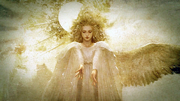
Luna in the painting of the prophecy.
The way Lunafreya is presented by in-universe religious iconography parallels the Woman of the Apocalypse, a major salvific figure from the Book of Revelation.
The Woman of the Apocalypse is described "a woman clothed with the sun, and the moon under her feet, and upon her head a crown of twelve stars". (12:1) This woman is pregnant—"travailing in birth, and pained to be delivered" (12:2)—with a child destined to grow into a "man who will rule with an iron rod". She is chased by "the Dragon", Satan, who seeks to devour her child. As the Dragon wages its war in the heavens, the Woman escapes into the wilderness of the Earth. The Dragon gives chase and floods the land with its breath of water, but Heaven gives wings to the Woman so she can escape and the earth itself absorbs the water. The Dragon sets out "to make war with the remnant of her seed, which keep the commandments of God, and have the testimony of Jesus Christ". (12:17)
While Lunafreya's story may not directly reference each of these elements, aspects of the Woman are still significant in her design and imagery, and the parallels deepen when considering several other figures traditionally associated with the Woman—the Blessed Virgin Mary, the Church, and the Bride of the Lamb.
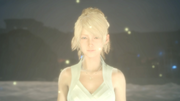
Lunafreya disappears into the "astral realm".
After Lunafreya's death her body is assumed physically into the spiritual realm and her intercessory role doesn't stop with her death; in fact, her capacity to serve her king only increases posthumously. Lunafreya's self-sacrificial obedience reflects the Blessed Virgin's fiat—"let it be done unto me according to thy word". Lunafreya is willing to abandon even her individual desire to be with Noctis to fulfill her calling. The Blessed Virgin is often associated with the moon, as she reflects the light of her Son's sun. "Luna" means "moon".
Lunafreya represents organized religion in Eos. She gifts healing and spiritual protection, and demonstrates a superhuman capacity for forgiveness, praying even for Ardyn's salvation immediately after being mortally wounded by him.
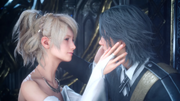
Lunafreya weds Noctis.
Lunafreya's connection with the Bride of the Lamb is possibly the most overt, as her story ends in a spiritual marriage to the King of Kings on the very throne where he laid down his life for the salvation of the world.
Ravus[]
Ravus Nox Fleuret is evocative of Pontius Pilate, the Roman governor over Israel under colonization as Judea. He was the active pursuer of Jesus under King Herod's rule due to Herod's paranoia of being usurped as the king of Israel, and eventual judge and executioner who ordered Jesus's crucifixion. During his authority, Pilate was said to have engaged in various acts of cultural, religious, and lawfully abusive violation against the Jewish people. Ravus's role as general of Niflheim's forces is suggestive of this, and his coveting of the Sword of the Father is an act condemned by many in Lucis.
His Technique is called Last Rites. Last rites are the final prayers and ministrations given by priests or religious ministers shortly before a person's death. The last rites go by various names and include various practices in different traditions, though the most obvious point of reference is the Catholic sacrament of the same name (which, in recent times, is often referred to as the Anointing of the Sick).
Ardyn[]
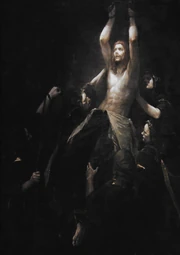
Ardyn Izunia being imprisoned on Angelgard.
Ardyn Izunia, in juxtaposition with Noctis, alludes to the archetype of the Devil. He at times wears an accessory that resembles a black wing, likening him to a popular image of a fallen angel.
In Christian terms he is comparable to the Antichrist, one of three major figures associated with the end times. The Antichrist claims to be Jesus, but ultimately represents the perversion and abandonment of Christian principles. Ardyn frequently presents a dark mirror of Christ, particularly in the game's concept art. In one piece depicts Ardyn riding a black chocobo into a city to prayers and cheers, just as Jesus rode a donkey into Jerusalem on Palm Sunday. ![]() Another piece depicts Ardyn stripped shirtless and chained up by people in black robes and providing a visual parallel to certain depictions of the removal of Christ's body from the Cross. When this scene is portrayed in Episode Ardyn, Ardyn's chains are attached to spikes nailed through his palms, alluding to crucifixion. Ardyn's first death reflects the crucifixion in another way. In Episode Ardyn Prologue, he is impaled by a spear, which hearkens to the piercing of Jesus's side and heart by a lance as He hung on the cross. Like Jesus, Ardyn was 33 years old at the time of his death.[1]
Another piece depicts Ardyn stripped shirtless and chained up by people in black robes and providing a visual parallel to certain depictions of the removal of Christ's body from the Cross. When this scene is portrayed in Episode Ardyn, Ardyn's chains are attached to spikes nailed through his palms, alluding to crucifixion. Ardyn's first death reflects the crucifixion in another way. In Episode Ardyn Prologue, he is impaled by a spear, which hearkens to the piercing of Jesus's side and heart by a lance as He hung on the cross. Like Jesus, Ardyn was 33 years old at the time of his death.[1]
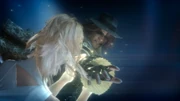
Ardyn's corrupted spirit.
Despite Ardyn's own belief that his power to extract the Starscourge from others meant that the Astrals had chosen him to be the world's savior, they denounce him because the disease—Eos's equivalent of Original Sin—had not been truly purged and had actually corrupted him. In Episode Ardyn Ardyn learns that the Astrals' true intention for him is to consume Eos in darkness while concentrating the Starscourge into his own person so it can be wiped out by his death. He is fated to serve as a sacrificial lamb, dying to wipe the slate clean of sin.
Elements of Ardyn's betrayal by his younger brother Somnus resemble the story of Cain and Abel who were the first two sons of Adam and Eve. Cain's fratricidal rage against his brother resulted in the world's first act of murder. Like Abel, Ardyn is killed by his jealous brother in spite of his own selflessness; like Cain, the "jealous brother" becomes the Founder King of a city and receives a special divine blessing.
Emperor Aldercapt[]
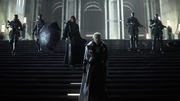
Iedolas Aldercapt with Ardyn (E3 2013 trailer).
Iedolas Aldercapt parallels the "Beast of the Seas" from the Book of Revelation, a figure often interpreted as the metaphorical representation of a tyrannical kingdom or empire. Niflheim could be seen as the Beast's "body" and Iedolas as its "heart". The Beast of the Seas is supported by the Beast of the Earth, who tempts everyone to worship him, much as Ardyn helped Niflheim gain the power it needed to usurp and conquer Lucis. The Beast of the Earth punishes anyone who refuses to worship the Beast of the Sea with death. In Final Fantasy XV, the empire enforces its rule by employing magitek soldiers, developed through the assistance of Ardyn, and by turning a majority of the Kingsglaive against their king.
Ultimately, the Beast of the Seas is tempted by the Dragon, who offers it the power and authority to rule. Iedolas's connection to the Dragon who defies the heavens can be seen in his desire to revive the glory of Solheim, an ancient civilization that was empowered by Ifrit, but toppled during the War of the Astrals as a result of its attempt to overthrow the gods.
Alternately, Emperor Aldercapt could be viewed with parallel with King Herod the Great, the Roman Empire Jewish client king who is viewed with infamy for the Massacre of the Innocents, in where Herod ordered the death of infants within and around Bethlehem in attempts to kill Jesus as a baby upon receiving word of the coming of the True King by the Three Magi. At the end of Herod's life, Herod was said to have suffered in putrefying illness and poor health.
Ifrit[]
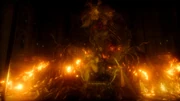
Ifrit on his throne.
Ifrit is comparable to Satan, a fallen angel cast from heaven with his followers due to pride who seeks to destroy God's creations out of spite. In the Book of Revelation, Satan is known as the Dragon, one of three figures of evil. He stirs a war in heaven and is cast down onto the earth, where he prepares to wage war against God and incites a man to become the "Beast of the Earth", or the Antichrist. In Final Fantasy XV, Ifrit started the Great War of Old and was subdued by the other gods. Later, he ends up being infected with the Starscourge and subjugated by Ardyn.
Ifrit granted mankind the knowledge of fire back in the Old Calendar Era, which allowed humanity to flourish and build a grand civilization known as Solheim, but man became blinded by his own hubris and turned against the gods, leading to Solheim's downfall.
In the Book of Genesis, a serpent, sometimes considered to represent Satan, tempted Adam and Eve to eat the fruit of knowledge, which led to them being cast out from paradise. In Final Fantasy XV, Ifrit seeks to "banish man from paradise" himself by razing the civilization mankind had built with the help of his blessing of knowledge.
Ifrit also has similarities with Samael, a Jewish archangel known as "the Venom of God", who tests and judges humankind in the face of sin and temptation. Samael is an ambivalent figure who represents both good and evil brought down by God and is considered the opposite of the archangel Michael. Samael is also known as the Angel of Death, and is sometimes conflated with the traditional depictions of Satan. In the Pirke De-Rabbi Eliezer, a series of retellings of Biblical stories, Samael is depicted as a djinn-like angel who is both the original tempter of Adam and the original father of Cain.
Bahamut[]

Bahamut holding Noctis on the palm of his hand.
Bahamut's role within Final Fantasy XV may parallel the Archangel Michael, who is considered the Sword of God and the leader of God's forces against the Dragon in the Book of Revelation. In art, the Archangel Michael is often portrayed carrying a sword, a set of scales, or a banner, and is frequently shown standing in triumph over a dragon.
Michael is regarded a saint in many Christian denominations. Within Catholicism, he is the patron saint of the people of Israel, military and civil services, produce and food, as well as healing sickness. He is considered to be a spiritual warrior, the protector of the Catholic Church, and an ideal representation of both the victory of good against evil and the importance of fighting evil within. He is sometimes shown redeeming recently deceased souls and granting them passage into heaven. Within Islam, Michael is regarded as the archangel in charge of the forces of nature.
The War of the Astrals, where Bahamut defeated Ifrit, may thus parallel the War in Heaven described in the Book of Revelation waged between the forces of the Archangel Michael and the forces of Satan, who are defeated and thrown down to the earth.
In Final Fantasy XV: Comrades, Bahamut's role takes on a purgatorial dimension, as he revives the traitor Glaives and demands they atone for their sins by fighting for the king they had rejected.
Bahamut's role in Episode Ardyn and to a lesser extent Dawn of the Future of deliberately setting up the events leading to Ardyn becoming the embodiment of the Starscourge as part of his overarching plan of having Noctis end it by slaying him bears some resemblance to God's setting up the events of the rapture as well as the anti-Christ's life and death in the "left behind" books.
The Starscourge[]
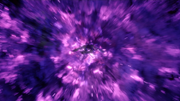
Ardyn embraces the Starscourge.
The Starscourge is similar in many ways to the concept of "Original Sin", which Christianity believes was brought upon by Adam and Eve in the Garden of Eden after the serpent tempted them to eat the fruit of the Tree of Knowledge. The only way to absolve and repent of the Original Sin is to turn to Jesus Christ—who came to die for the sins of mankind in the New Testament—as savior.
Noctis gives his life to end the Starscourge as the True King to return to the Crystal's light to the planet and to bring absolution to Ardyn's soul and, ultimately, to atone for the original sins of the Caelum family that caused Eos's present suffering.
Insomnia[]

Insomnia.
Insomnia is reminiscent of both the land of Zion and the city of Enoch, the first city said to have built by Cain and his family.
Zion is a Biblical name for the city of Jerusalem, the holy city of the Jewish peoples. After King Nebuchadnezzar II enslaved the Jews, Zion took on a mythical status as a paradisiacal land of freedom and safety, an association which took root in both Black American culture and Rastafarianism. In Christianity, it more frequently refers either to a state of spiritual peace or to Heaven.
Enoch, meanwhile, was created by Cain, the first fratricide. While he and his descendants lived prosperously as Enoch's founders, they were oblivious to—or even responsible for—the hardships of those of lesser status, and the city of Enoch itself provided a parable demonstrating how cities draw the worst out of men.
Niflheim[]

Niflheim forces invading the lands of Eos.
Niflheim parallels Babylon, the oppressive and exploitative city opposed to Zion, which represents the corruptible materialistic aspects of the world. In Judaeo-Christian tradition, the name of Babylon is believed to be derived from the Tower of Babel. As a result of the display of hubris demonstrated in its construction, mankind suffered a great confusion through the mixing of their tongues and was dispersed throughout the world. Babylon is consistently portrayed as as a kingdom of oppression that must be opposed until its ultimate destruction as one of the heads of the Beast of the Seas in the Book of Revelation.
The end of the world[]

The Book of Revelation describes many fantastical beings of chimerical features believed to be allegorical depictions of major figures of divine intrigue that would help orchestrate the end of the world, or would salvage those who would be worthy of a new world after the destruction of the old. Much of the imagery of Revelations describes major disasters that render the world nearly uninhabitable and wipe out great populations before its ultimate destruction and recreation. Revelations mentions an empire as a major catalyst for this event; many scholars conclude this to be the foretelling of the end of the Roman Empire, who at the times of Jesus's adult life oppressed and colonized over Israel and the Jews.
The Four Horsemen of the Apocalypse signal the end of the world as told in the Book of Revelation, described as ghastly beings who ride on steeds and bear armaments that represent the events they signal. Throughout Final Fantasy XV, their order of appearance is significant:
The first is Conquest, popularly known as Pestilence, who comes riding on a white horse bearing a crown and a bow. Conquest is interpreted to be the rise of an empire coming to conquest, or a religious zeal similar to or is that of Christianity bent on converting the world into its faith with force. Pestilence is also believed to be the spread of fatally communicable disease and plague. Some also believe Conquest to be the coming of the Antichrist.
The second is War, who rides on a red horse brandishing a greatsword. Though War represents battle, it is also believed to represent genocide and mass slaughter, as well as an empire's collapse.
The third is Famine, who comes riding on a black horse and carries weighing scales. Famine signals times of hardship and economic collapse, as well as imperial oppression as the empire is in its last straits.

Ardyn wielding a scythe.
The last of the Horsemen is Death, who comes riding on a "pale" rotting horse, and is believed to be followed by the Grim Reaper or Hades. It is sometimes depicted wielding a scythe. It signals waves of casualties and the aforementioned empire would face its end by judgment through "sword, famine, pestilence and wild beasts".
Buddhist parallels[]
Noctis[]
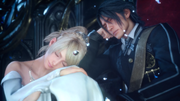
Noctis and Lunafreya rest.
Noctis stemming from royal blood could allude to that of Siddhartha Gautama (Buddha) before enlightenment, who was a warrior prince and whose birth was in some accounts destined to be the forthcoming of a great figure of salvation. The Caelum bloodline resembles the Shakya clan which Buddha hailed from, who ruled by warrior royalty over their state and worshiped the sun in ancient India, which they believed was their origin. Two of Noctis's ancestors, the Conqueror and the Mystic, are known as the Asura King and the Yaksha King in the Japanese script, further alluding to the times predating Buddha.
Buddhism has tales of bodhisavvas (bodhisattva is anyone who has generated a spontaneous wish and a compassionate mind to attain buddhahood for the benefit of all sentient beings) having attained Nirvana by reaching buddhahood and transcending the mortal world's limits. However, Parinirvana—or dying into Nirvana—was how Buddha himself transcended. Like Buddha, knowing of his time to pass on, Noctis says his farewells, and accepts his death. Reunited with his beloved in the next world, Noctis and Lunafreya ascend freely into rest. It is unknown what the afterlife is like in the world of Final Fantasy, but their happiness together implies they have transcended the needs of the living world into the beyond.
Noctis's friends[]
Gladiolus, Ignis, and Prompto resemble some of Buddha's followers who accompanied him to help and protect him on his journeys. Within the context of Buddhist iconography and symbolism, specifically within Japanese Mahayana Buddhism, Buddha is popularly portrayed with his followers at his side. This not only represents Buddha's teachings reaching out to others of different walks of life, but also exemplifies his virtues and different ways buddhahood can manifest.
Gladiolus[]
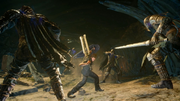
Gladiolus Amicitia.
Gladiolus can be seen as that of Shukongoshin or Vajrapani, who in legend was Buddha's fierce but benevolent bodyguard. Origins vary on how Vajrapani came into Buddha's following, but a Japanese legend states that a king had a second wife who bore two children who would become the Nio—Japan's interpretation of Vajrapani as Buddha's twin protectors. The eldest, more aggressive son, Kongo Rikishi, wished to grow up to defend Buddha from evil and ignorance. Portrayals of Vajrapani often depict him as a muscular warrior and/or a yaksha, powerful spirits of nature found within Buddhism and Indo-Asian religions and mythology. Greco-Roman Buddhism studies also find that inspiration for his mighty figure stems from the artistic depictions of the hero Heracles.
Symbolically as a bodhisavva, Vajrapani represents Buddha's power and the might of the enlightened mind. He is known as the Master of Unfathomable Mysteries who upholds truth even in adversities of darkness and ignorance. Represented with him is his eponymous vajra, to represent the indestructibility of the truth and its irresistible attraction.
While Shukongoshin is his own representative deity within Japan, he is overlapped with Acala or Fudo Myoo, the leader and most popular of the Myoo, or the Bright Kings, Japan's interpretations of the dharmapālas. A dharmapāla is a type of wrathful god in Buddhism whose name means "Dharma protector or defender" in Sanskrit. He is the wrathful but benevolent bodhisavva who represents the activeness of the enlightened mind. Dharmapālas protect those who practice Buddhism while slaying evil and taming the excesses that lead into suffering through shocking viewers with their powerful imagery.
Fudo Myoo is shown with a sword surrounded by a dragon, which is believed to be a rival deity tamed under his control, and whose hilt in some depictions is a vajra; a lasso, representative of taming excesses; seated upon a rock base, to represent his immovable steadfastness; an aggressive but stern temperament; and surrounded in flames, showcasing the ability to purify. Fudo Myoo is also associated with wealth in Japan, as religious pilgrimage sites feature him near waterfalls and bodies of water, where he is invoked while washing money and valuables. He is also related to the removal of obstacles, including concepts such as poverty and want.
Within the context of the Chinese zodiac, Fudo Myoo reigns over the year of the Rooster. Vajrapani's ability to transform into a garuda is relevant to this imagery, the giant eagle of Hindu myth, to protect the nagas during their sermons by Buddha. The karura, meanwhile, are giant bird-like humanoids powerful enough to take on dragons, prevalent within Fudo Myoo's imagery. Gladiolus has a large eagle tattoo that he got when he became Noctis's Shield, as is the tradition in his family.
In context of the Nio, Gladiolus's sister Iris can be seen as Ungyo or Non-o, the youngest sibling, who represents feminine, latent aspects, and protects good entities.
Ignis[]
Ignis alludes to Monju Bosatsu or Mañjuśrī, the bodhisavva of wisdom, intelligence and willpower. Mañjuśrī is the oldest and most significant bodhisattva in Mahāyāna literature. He is portrayed as Buddha's wisest follower and helper in the Sangha ("community"). He is depicted as eloquent, understanding, patient, and beautiful. He is said to have a marvelous voice, an eternally youthful appearance, nearly unshakable demeanor, and to be incredibly charismatic. When combined with his infinite wisdom, this allows him to be straightforward and outreaching to teach others Buddhist virtues.
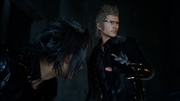
Ignis Scientia.
Symbolically as a bodhisavva, Mañjuśrī represents Buddha's wisdom and the power of transcendent wisdom that helps lead to enlightening the mind. He is known as the Voice of Buddhist Law, helping represent the faith with both insight and good graces. Represented with Mañjuśrī is a flaming sword, said to represent wisdom cutting through ignorance; a ruyi scepter, said to represent sagacity and good fortune; the Prajnaparamita Sūtra, representative of study and constant refinement to perfect one's understanding of wisdom; a blue lotus, representing enlightenment through transcendent wisdom; and a blue tamed lion, representative of wisdom taming the mind, and its roar signaling dharma overcoming all obstacles.
From Chinese art, Mañjuśrī was given the aesthetic trait of having five curls, or peaks in his hair. These are said to represent five crucial focuses of wisdom in Buddhism: wisdom against anger, envy, desire, ignorance, and pride. In Japan, Monju Bosatsu is revered as the bodhisavva of grace, academics, and studies, and was also once revered as the god of the kitchen, symbolizing the wisdom and discipline to be observed and practiced for the maintenance of the home and hearth.
Prompto[]
Prompto can be seen as that of Fugen Bosatsu or Samantabhadra, the bodhisavva of practice and conduct. Fugen Bosatsu is popularly revered in Japan and resonates the most with Japanese values, especially that of makoto—dedication, persistence, and unyielding sincerity. Symbolically as a bodhisavva, Samantabhadra represents Buddha's compassion, the importance of conduct and application of wisdom, and the infinite promise of hope and salvation to anyone that they can change their ways for the better, and that all have the potential to reach enlightenment.
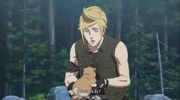
Prompto Argentum in Brotherhood Final Fantasy XV.
Represented with Samantabhadra is the lotus, showcasing transcendence as it blossoms and spiritual growth as it grows out of the mud; and a lotus leaf parasol, a symbol of the purity of dharma protecting the downtrodden and faithful. Atop is a white elephant with six tusks, representing both the six sensations that must be overcome to achieve salvation—pride, jealousy, desire, ignorance, greed, and hatred—and the six paramitas to try and apply to one's daily life—generosity, ethical conduct, patience, diligence, meditation, and wisdom. The elephant itself represents the unstoppable nature of devout passion, and the virtues of Buddhism overcoming all obstacles.
Within the Chinese zodiac, Fugen Bosatsu is associated with the signs of the Dragon and the Snake. Asian dragons are said to transform from snakes and carp after years of practice and overcoming trials. Fugen Bosatsu is also a patron bodhisavva of women, as he is the keeper and protector of the Lotus Sutra, which entails the evidence of women also being able to reach enlightenment.
While Prompto does not have the most visual and conceptual traits as compared to his teammates, he has them in spirit, as Fugen Bosatsu is also known as the "Bodhisavva Whose Beneficence is Everywhere". A popular tale within Japanese Buddhism regards a priest who wished to witness Fugen Bosatsu. He was directed to the residence of a courtesan in the city, and upon witnessing the courtesan entertain her patrons, Fugen Bosatsu revealed himself to the priest as the courtesan. Fugen revealed to the priest that all have his essence and play their role of universal importance in every different life. Prompto being himself, along with his unwavering friendship and constant efforts to be useful, help underline this the most.
Cid[]

Cid Sophiar with Talcott Hester.
Cid Sophiar could allude to Yuima, or Vimalakirti, who within Buddha's original sangha was touted as the paragon layman of Buddhism. Although not a bodhisavva, Yuima was revered for exemplifying the ideals of the Middle Way that Buddha spoke of in his teachings, including showcasing the importance of the ordinary within everyday life. While Yuima was erudite, he was also a worldly individual, an accomplished family man, a spirited entrepreneur, and an upper class citizen who wisely amassed his wealth for the charity of others. Yuima was respected in many crowds for his openmindedness and harmonic engagement with the everyday person of all classes. His wisdom allowed him to deal with many sorts of people, including showcasing energy and activeness to inspire the lazy, and street smarts to outdo the foolish. His most famous depiction is within the eponymous Vimalakirti Sutra, in which Mañjuśrī visits him to discuss the Dharma.
Gilgamesh[]
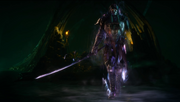
Gilgamesh.
Gilgamesh could be inspired by the Buddhist monk Bodhidharma or Bodai Daruma. While not with a direct inspiration in religious imagery, much of Gilgamesh's depiction in Final Fantasy XV echoes Bodhidharma's lore.
According to legend, Bodhidharma is the founder of Chan and Zen Buddhism, and a patron figure of the martial arts, including the introduction of the exercise teachings which would become the martial arts of the Shaolin Monastery, and a sagacious figure of patience and diligence for samurai. While nothing is truly known about his core insights and inspirations, his influence and acts of expediency during his pilgrimages are among the more famous of his achievements. Many consider that he taught by action and personal experience over words and intellect. Depictions of his figure often portray him as a "man from the West, with blue eyes" with a rough and surly figure cloaked in a red robe. Within Japan, Bodai Daruma's imagery is everywhere in the popular culture, tied to many aspects and workings of life.

Gilgamesh magically creates himself a left arm to replace his lost limb.
One of Bodhidharma's most famous feats was to meditate for nine years upon being denied entry to the Shaolin Monastery in his first visit. Seating himself in a nearby cave, he meditated motionless, and according to some interpretations tore off his eyelids in shame for having accidentally slept during this period. This attracted followers, and one such followed, Dazu Huike, wished to become his apprentice and even cut off his left arm to show his devotion to Bodhidharma's teachings.
While Bodhidharma is said to have died at the age of 150 in China, the matter of his death is considered a conflicting account. More fantastical stories tell that Bodhidharma merely rose up from his grave, and having left a sandal behind at his tomb, went home, having achieved the powers of immortality through the ways of the mystical beings of Xian, which liberate one from mortal existence.
Lunafreya[]
As Noctis's fiancee, Lunafreya is reminiscent of that of Yasodhara, the wife of Buddha. Said to be a princess, Yasodhara was shocked upon Siddartha's immediate departure after the birth of their son Ragula. Upon learning of his departure to attain the hallowed goal of enlightenment, she remained faithful to him by emulating his practices on his quest through correspondence and news of his deeds. Though the two do not yet have a home proper by the time of their elopement, Lunafreya likewise carries on her own quest as her fiance travels to fulfill his destiny and gather his resources. She prepares for him to take on the Astrals' trials and continues her duty as a sacred healer.
Ravus[]
Ravus Nox Fleuret is reminiscent of Devadatta, who is regarded in Buddhism as Buddha's cousin, former bodyguard, and eventually antagonistic rival. According to legend, Devadatta became inspired by Buddha's attainment of enlightenment, but was more enticed by the social and political graces than the profoundness of the Sangha's teachings. Though he desired Buddha's spiritual powers, his were an imitation, yet influential enough to fall into the graces of the local kingdom. Still, Devadetta's wisdom and insight paled to Buddha's. Many of his followers were led astray from Buddha's own layhood, and established austerities that were baseless and impractical to spiritual development. Devadetta abused his power, from hiring killers, to practicing violence, slander, and selfishly influencing royalty against Buddha to establish his own school's fame to outshine the Sangha.
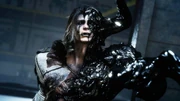
Daemon Ravus.
There are many tales of the end of his life. One states that Devadetta succumbed to disease before he could make amends for his wrongdoings in light of the realization of his guilt. Another states Buddha ended his life personally during a disguised attempt to assassinate him. Both end with Devadatta falling into the most punishing depths of hell.
Like his sister, Ravus's alluding elements can be seen in his role in the story, including desiring to claim the legacy of the Lucii from Noctis and siding with the Niflheim Empire. In the end, he becomes a daemon after Ardyn, posing as Noctis, kills him. This also plays to the angel and demon juxtaposition with his sister Lunafreya, who is depicted with an angel wing in the logo and in the painting of the prophecy.
Ardyn[]
In terms of Buddhism, Ardyn can be seen as alluding the one of many forms of Mara or Namuci, who is known as the Tempter or the Demon King within Buddhist lore. Mara is a demon who attempted to lead Buddha astray from his path to enlightenment. In Buddhist thought Mara is known to take on many forms—some corporeal and concrete, some conceptual and abstract. Ardyn can be seen as that of Mara when first encountering Buddha, as a person with a soft-spoken demeanor but ultimately being dissuasive and deceiving.
Emperor Aldercapt[]
In terms of Buddhism, Iedolas likely represents the demon Mara on the account when he confronts Buddha in the form of elderly, weary men—one was a farmer, the other a brahmin (the highest caste in Hinduism)—to remind Buddha of the inevitable fate of death, passing of all things, and the fear of a tiring, dull, and fruitless life. Upon dispelling Mara's disguise, Mara took the forms of natural disasters, dangerous animals, objects of instinctual sensual desires, and even the unsuspecting calm of life, to frighten into Buddha the fear of death. He was overcome when Buddha told of his outlook on life, that though human life can be short and fleeting, it is also precious, and that through modesty and bravery, one must strive to attain what one's heart needs most to achieve enlightenment in their own way. While Noctis's journey throughout Eos is a metaphor for this, this all comes to a head when Iedolas succumbs to the Starscourge and becomes the daemon Foras in Zegnautus Keep, where Noctis is stalked by the daemon at his most vulnerable.
Ifrit[]
In Buddhist terms, Ifrit can be seen as Mara taken form as Namuci or Dairokuten Maou, who is said to be the Demon King proper. He is the divine being who keeps all in the desire realm—a realm of sensual and material sensations that includes the six realms of existence, one being the world of Men—under his control. Mara is the ultimate obstacle of enlightenment through his temptation and the employ of his demon hordes to keep all in fear and eternal cycles of Samsara at his enjoyment. Being related to fire alludes to the teachings of Buddha, who used fire as a metaphor for suffering and desire.
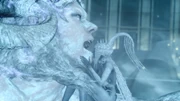
Ifrit defeated by Shiva.
Mara's most notable appearance is when he confronts Buddha on the grasp of enlightenment. Mara offers sensual delights and temptations, which are dispelled by Buddha's understanding. Mara resorts to threats and summons his demon armies, who are defeated when Buddha gives evidence of those who bear witness of his achievements, being that of the Earth and all of the heavens, who come to Buddha's side. Noctis, likewise, leads the battle against Ifrit who is summoned by Ardyn. As Noctis continues on, the Astrals, too, come to his side as those who bore witness of Noctis's feats, helping him defeat Ifrit.
Souls and death[]
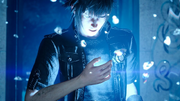
Floating crystalline specs demonstrating Noctis's connection to his ancestral souls.
Śarīra are spiritual relics of Buddhist nature, which are the crystallized remains of bodhisattvas found after cremation, and made existent after the passing of Buddha. It is believed that they embody the spiritual knowledge, teachings, realizations or living essence of spiritual masters prior, and are taken as evidence of the masters' enlightenment and spiritual purity. The bonding of souls and the crystalline fragments that represent spiritual energy strongly resemble this, just as the Ring of the Lucii bestows upon the wisdom of Lucian kings past.
Cars[]

The party driving the Regalia.
The feature of cars in Final Fantasy XV hearkens to many wordplays and features of transportation within Buddhist lore. During Buddha's getaway from his father's palace, his royal servant Channa helped him by driving the chariot.
The Regalia hearkens to the idea of the Great Vehicle, or Mahayana. Buddha explains that though insights made by one's own journey are important, he had decided to help spread his teachings to help guide along others to the truth. He termed his teachings as a vehicle to help expedite others along their way. For Noctis and his party Regalia is their form of transportation to uphold their role as Lucis's protectors and to help guide them along toward Noctis's fulfillment.
Food[]
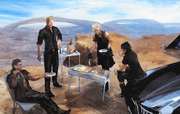
Concept art of the party cooking and eating.
Nourishment is a subject of importance to the insights of the human condition in Buddhism, and was central to Buddha's story of religious pilgrimage. While vegetarianism was venerated even before Buddhism through Hinduism, Buddha's abstinence of food nearly emaciated him before being saved by the food alms from a young woman. In the Theravada tradition, not everyone reacted well to meatless diets that the rich were able to afford, including Buddha's life in his household, and while the act of killing was not right and could promote suffering, food is necessary to survive, including the raising of livestock for meat and how humans are physically prepositioned as meat-eating and hunting omnivores. Buddha did not advocate for vegetarianism when he started the Sangha, instead allowing for alms of meat dishes as long as it was not seen, heard, or expected, and were not of majestic, cognitive, or unclean wild animals, and considered veganism and ascetic diets baseless when Devadatta started his mutinous schism.

Ignis with his coffee.
In Final Fantasy XV food helps Noctis and his party survive both nutritionally and emotionally. The nature of Eosian wilderness is one where the beasts are dangerously feral, powerful, and demand culling to ensure the safety of civilization. Noctis's distaste for vegetables may mirror historic displacement and open ended interpretations of the past as with Buddha, as despite being predestined as the True King, Noctis is just as human as any other. Ignis is a connoisseur for a certain type of coffee, while tea in Buddhist practice is used to promote awakeness in meditation.
Lucis and Insomnia[]

City of Insomnia.
Within Buddhism, Insomnia is reminiscent of the palace of pleasures provided to Buddha by his kingly father in his youth, and Buddha's Parable of the Burning House. According to tales of Buddha's life, Buddha was sheltered into his young adulthood by his father and was confined to his home. While his father did so out of goodwill to protect his son, and provided to Buddha endless pleasures and indulgences, this only brought Buddha closer to the want of seeing the outside world. According to development notes, Insomnia is based on many major metropolises within the real world, most notably Tokyo and New York City. Such cities are heralded as places of entertainment, wonder, luxury, excitement, and social hotspots, while in return, some eye the country as a place of tranquility away from the busyness of city life. Within many religions, including Christianity, the depths of nature is considered the place best to spiritually develop oneself.
The Parable of the Burning House details the story of a rich father of many children and a vast degree of wealth and property, who had lived in a long-neglected and weathered house. When the house had caught fire, the father had tried to get his children to safety, who were too engrossed in having fun, oblivious to their danger. Knowing of how pampered and sheltered his children were, the father then led them to safety with the white lie that he had prepared for them a great gift and that they could play with their new toys as soon as they could reach it. Documented within the Lotus Sutra, the parable is especially valued for its display of upaya, or skillfulness, to teach the importance of expediency for the sake of the greater good, and that the truth does not always come in the same form nor is received all the same, especially within the context and perspectives of different lives.
The end of the world[]
Descriptions of Mappo, the Buddhist endtime, vary widely, though all bear themes of existential misery and great suffering. Japanese Buddhism dated from the Heian Era describes Mappo as the days when the universe has exhausted its karma. The earth itself would rupture open, its fissures leading into Naraka (Hell), and out would pour demon consorts of Yama, the Judge of the Dead, to capture those who have not repented for their karma to be thrown into the depths of eternal damnation. Only those who turn to Buddha and his bodhisavvas would to be saved.
Dreams[]
Elements of dreams and sleep are a recurring theme within Final Fantasy XV. Ever since its incarnation as Final Fantasy Versus XIII, the song "Somnus" has been the installment's leitmotif, its lyrics describing the coming of darkness before a new dawn. The Platinum Demo ventured into the dreams of an unconscious Noctis, while Omen is a premonition witnessed by King Regis, parts of the short film appearing in the game as a nightmare experienced by Noctis. Some of the more powerful equipment is tied to dream and sleep motifs, such as the Pendulum and the Hypno Crown. The Crown City of Lucis is also called Insomnia. When Noctis is pulled into the Crystal of Eos, he must sleep for ten years to gather his power to end the Starscourge.
Dreams relate to consciousness and the perception of reality. Within the practice of dream reading, a dream's events and imagery are analyzed to uncover a correlation within the dreamer's own reality, as it is believed such elements are the manifestation of the expression of the subconscious mind. Dreams also relate to psychic ability and divinity, as premonitions both auspicious and ominous have influenced their dreamers to act accordingly. Daydreaming is fueled more by imagination and curiosity, as it takes focus away from reality into one's mind. Finally, dream can be seen as inspiration to take into the living world.

A dream in Omen.
Within the insights of many philosophers exists the perspective that life is much like a dream of its own, some believing life is a dream of the heavens. Buddhism holds the idea that reality is an illusion, and that the sensations and the objective world are purposeful but fleeting. To attain enlightenment, meditation is the most touted way. Many studies and principles are related to the matters of the mind to reach Nirvana, hence awakening oneself to enlightenment.
Within Buddhist cosmology, Nirmaannarati is one of the six heavenly planes of the Desire Realm where beings who are incarnated there become devas indulgent on entertainment. In their perspective life in the human realm is a passing dream, as a day within Nirmaannarati is said to be the equivalent of 8000 years. Within Japanese culture, the Noh play of Atsumori is famous for a song detailing the juxtaposition of Nirmaannarati to the human world to emphasize the impermanence of life. While life in the deva realms is considered the most opulent out of the Six Paths of Samsara, it is considered that the life of a human, despite man's fragility and fleetingness, is easier to take on the path of enlightenment.
"Skillfulness"[]
Upaya is an esteemed trait encouraged in Buddhism, regarding the manner one learns to be guided on their way to enlightenment, both oneself and teaching others. Though there are many ways to enlightenment, Upaya involves consideration for others and being skillful in the technical sense, as enlightenment is considered not just in the manners of the religious, but also in what one finds their spiritual dimension.
Noctis's way to enlightenment is not just through maturity and overcoming hardship. The lands of Lucis face economic disparity and an uncertain future. From his travels, Noctis is motivated to become king to help protect his nation, improve his people's lives, and restore its prosperity. He starts by undergoing the work that the people themselves do to understand their perspective. His friends also realize their own purpose on the path they share along with their own lives.
Miscellaneous/comparative parallels[]
Noctis[]
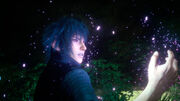
Noctis Lucis Caelum.
Many elements of Noctis Lucis Caelum appear to draw upon central figures of major religions, such as Buddha and Jesus Christ. According to their respective tales and history, a common theme is that of journeys, including religious pilgrimage. Buddha's travels through his nation of India allowed him to get away from the over-protectiveness of his father. Being unaware of the human condition and suffering, it inspired him to understand the way to free oneself from the extremities of mortal life. Eventually his enlightenment and attainment of Buddhahood allowed him to evade the collapse and familial annihilation of his bloodline.
Jesus traveled throughout Israel and the Near East to spread the Word of God and his messages of his ministry, and to evade the wrath of the authorities who feared his influence as the miraculous Son of God and the Messiah, which he concealed until his death.
Likewise, Noctis journeys to become the True King in safety from his kingdom's enemies and treachery from those closest to his father. This opens his eyes to the state of the world and motivates him to succeed for the sake of everyone.
Gilgamesh[]
Gilgamesh's incarnation in Final Fantasy XV retains many of his prior inspirations, such as the namesake hero of Babylonian myth and the warrior monk Benkei of Japanese folklore.
Lunafreya and Aranea[]
Lunafreya Nox Fleuret and Aranea Highwind share many allusions to central and influential female figures of major religions, and have distinct imagery that helps separate them as characters. This may have been done to evoke a sense of dualism, a design element and recurrent theme within Final Fantasy inspired by its recurrence within real world philosophies and spiritualties.
One divine figure is Nyorin Kannon, a syncretic combination of the two most popular female figures of Buddhism, Benten or Sarasvatī—the Buddhist goddess of the waters and the arts—and Kannon or Avalokitêśvara—the bodhisattva of mercy. The two are venerated within Japanese syncretic Buddhism and Shinto.
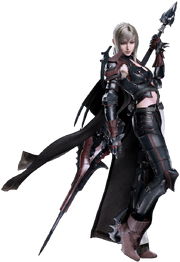
Aranea Highwind.
Benten originates as a Hindu water goddess, and her messengers are the Asian dragons. Within Japanese Buddhism they replace the nagas, the serpentine spirits of the waters found within Hindu legend. Since her adoption into the Japanese pantheons, Benten has adapted into many facets of life. Through artists, Benten is one of the Seven Lucky Goddesses who lords over anything that flows. To samurai, an eight-armed mighty warrior woman, known as Happi Benten, protects the ways of Buddhism. Happi Benten wields many weapons, including a spear. She is a figure of beauty and liveliness, representing the grace and sensual power of women.
Kannon is the most revered female bodhisattva within Buddhism throughout Asia. She is beloved for her willingness to help the world until all beings attain buddhahood. Though Kannon is venerated as female, deeper thought perceives her as neither gender, and of any possible gender to a worshiper, showcasing how everything is illusive nothingness in form. As a bodhisattva, Kannon has been tried and tested in her path, including being overwhelmed by the myriad pleas for help. Within Chinese Buddhist art, Kannon is depicted on a dragon, and is flanked by two warriors: Guan Yu and the bodhisavva Skanda or Idaten. They are famously depicted from the literary fantasy epic Fengshen Yanyi. Aranea is a dragoon and wears draconian armor, and two soldiers loyally serve her: Biggs and Wedge.
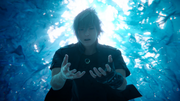
Luna gives Noctis the Ring of the Lucii.
Nyorin Kannon incorporates both of their meanings, and ultimately, as the Buddhist representation of the Shinto goddess Amaterasu, incarnated as a bodhisattva to help the world with her wish-granting jewel. Within Japanese Buddhist lore, Nyorin Kannon represents Benten as the daughter of the Dragon God Sagara, who gives her wish-granting jewel to Buddha during his travels to reach enlightenment as spoken in the Lotus Sutra. Luna gives the Ring of the Lucii to Noctis so he may fulfill the prophecy. The Oracles' bloodline is implied to have gained its powers of healing from Bahamut, the "dragon god" of Eos.
Yin and Yang are one of the best known ideas of balanced dualistic concepts, also shown in the differences between Luna and Aranea. Yin is associated with darkness, the material, and the earthly, while Yang is associated with light, the spiritual, and the heavenly. Commonly, they are associated with the colors of black and white; black for Yin, and white for Yang. The Yin and Yang symbolism could also be seen in Luna and Noctis, as well as Tenebrae and Lucis.

Luna with a vase of sylleblossoms.
Luna's aspects fit the affinity for Yang. She dresses in flowing white garments and is also associated with the color blue for her eyes and the sylleblossoms she loves, both representing the color of the daytime sky. She is named after the moon, a celestial object; within China and Japan, the moon in classical mythology was regarded as the realm which the mythical rabbit that lived there pounded and made the famed elixir of immortality. Upon her death, this may reflect her returning to the heavens.
Aranea's aspects fit the affinity for Yin. She wears black and red, and while black can be taken for darkness, the red fits as an accompanying color, reminiscent of the sinister daemonic energy that emanates from magitek. As her outfits use more than one primary color, and are skin-tight with many pieces, this shows aspects of diffused and numerous, which relate to Yin. Her name refers to a species of spider that weave orbs, likely in contrast with Luna's moon. She is one of the few of the Niflheim Empire to survive after its demise. Her religious allusions take indirect references and draw upon them with a spun, or draw upon lesser known aspects of their lore.
While Benten and Kannon hold heavenly imagery and connotations, there are also aspects of them that relate to the infernal and the dead. From her original interpretations from Hindu faith, Benten was depicted widely as Happi Benten, and was placed closely to gods of the dead, including Yama, the Judge of the Dead. Happi Benten was also inspired by Kali and Durga, the goddesses of destruction, Shiva's destroyer forms. Within Kannon's lore, in the tale of the Legend of Miaoshan, Kannon is featured as the titular Miaoshan, reincarnated as a princess being forced by her father to marry a wealthy but uncaring suitor. Fleeing her father's whims to marry the suitor as a nun, he had her executed. He sent her to hell where she graced its terrifying depths with her compassion and transformed it into a paradise, an act that had Yama return her to life.
Ifrit[]
Ifrit defines the original definition of efreet found in Islamic lore, being enormous flaming derivatives of djinn that inhabit ruins and reside underground, and are feared for their wicked nature. Ifrit also resembles Iblis or Shaytan, who in Islam was a djinn that refused to bow down to Adam, the first human; some reasons state his pride as a djinn and the leader of a fellow tribe, others state of Iblis's loyalty to Allah being a flaw to where Iblis only saw evil and imperfection in man.
Bahamut[]

Bahamut's Ultima Sword.
The concepts of Asian dragons play off Bahamut's "King of Dragons" title. Within Asian mythology and religion, dragons are said to have created the world through breathing powerful and divine qi, and it is believed that crystals are the purest manifestation of the remnants of their sacred breath. They were said to bare crystal pearls in their claws, representing their closeness to the heavens, universal perfection, and the powers of creation. As beings of nature, dragons were said to herald rain to quench the earth, and to dwell deep underneath great bodies of water before ascending back into the heavens. Within Japanese and Okinawan folklore, Owatatsumi or Ryujin is a dragon king said to dwell at the bottom of the ocean within a majestic palace, and ruled over the seas and its inhabitants. Within Chinese legend, dragons transform from earthly creatures, such as snakes and carp, and attained dragonhood from great feats. Within the Taoist concepts of the Four Symbols, the Golden Dragon is considered a heavenly beast who is meant to be hidden, as it represents the element of Earth as a quintessential element, and rules over the greatest powers that govern over the Four Beasts.
The Astrals of Eos are associated with a classical element from the Final Fantasy series, although not all of the elements, e.g. Leviathan's water, are represented in Final Fantasy XV as gameplay elements. Whereas the other Astrals are linked to "earthly" elements, Bahamut is associated with the power of light or holiness. In the Japanese five elements philosophy, Bahamut could be seen as representing the highest element, 空 Kū or sora, most often translated as "Void", but also meaning "sky" or "Heaven". It represents things beyond people's everyday experience, particularly things composed of pure energy.
Carbuncle[]
Carbuncle appears to be an amalgamation of many religious lore and mythologies regarding its namesake. Its appearance hearkens to its recurring incarnation within Final Fantasy, a rabbit-like creature with a red jewel embedded into its head. Carbuncle is inspired by its original myth of a creature found in pre-settled Brazil and Chile that has been described as many different creatures, from armadillos to lizards and rodents. They share the trait of having a red jewel said to be crystallized dragon's blood that can cure any disease. Carbuncle in the Bible is a red precious gemstone said to be more radiant than a ruby, seen on the priestly breastplate of the High Priest of the Israelites in the Book of Exodus. The breastplate adorned with gems was said to represent God's will by His intervention regarding earthly affairs. Within magic lore regarding carbuncles and other red gems, they were believed to have powers to protect against bodily injury and drowning.

Carbuncle protects the young Noctis in his dream.
In Final Fantasy XV Carbuncle is a spiritual creature found in Noctis's dreams that has healing and protective powers. This is similar to the mythical beast baku, the mystical tapir-like creatures also said to be an amalgamation of many other animals, including elephants, tigers, and rhinoceroses. Throughout China and Japan, baku are heralded as the eaters of nightmares and wards against evil, with their motifs made adorning buildings and into charms to protect people. In Brotherhood: Final Fantasy XV, King Regis gives an injured Noctis a Carbuncle totem to protect him in his coma. Noctis's unique powers by the Ring of the Lucii may also draw upon the baku, including the ability to smite with sacred power and to whisk one's threats out of existence.
Souls and death[]
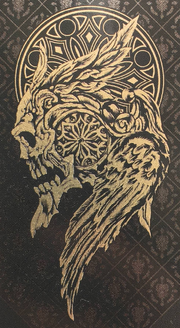
Emblem of Lucis.
In early development, the kingdom of Lucis was said to have worshiped the Goddess Etro, a key figure in humanity's existence and ruler of the afterlife, alongside related imagery of the Grim Reaper. Allusions to this were removed from the final game due to ratings concerns, but the symbol of Lucis is still a winged skull and skull motifs recur in the main party and Cor's attires.
Though it is alluded that such worship is to the deceased kings of Lucis's past, the revering of death figures also symbolizes many of the central beliefs of the aforementioned major religions regarding the sensual and material. It stresses the importance of spiritual pursuits and enlightenment and balancing one's secular and spiritual needs to avoid attachment and obsession to the mundane and materialistic, including the rejection and realization of how it is that of a spiritual dimension, rather than that of the fleeting material world, that brings about happiness. A peaceful death and release from the world without attachment in this context, is one of many highly regarded aspects of salvation and enlightenment.
The Starscourge and daemons[]
Kegare is a prime concept in Shinto, Japan's national religion, describing the importance of cleanliness and the need to wash away impurity, which is believed to stem from disease, filth, and the result of death and bodily harm. Some depictions state that extreme degrees of negative emotions and evil are also that of kegare on a spiritual level. Such states of impurity were believed to spawn demons and evil kami. One old belief of Japanese superstition was that sickness is the result of demons. In Final Fantasy XV the Starscourge is comprised of photosynthetic microorganisms, and the Japanese name for daemon is "corpses", (シガイ, Shigai?). The Starscourge thus works with the context of kegare as a malevolent disease that reanimates the dead into unholy creatures of darkness.

A daemon.
Dæmons are benevolent spirits that exist in classical mythology and are of the same nature as mortals and deities. However, the daemons in Final Fantasy XV are more akin to demons, supernatural and usually malevolent beings prevalent in religion. In the Abrahamic traditions a demon is considered an unclean spirit, a fallen angel, or a spirit of unknown type which may cause demonic possession. In Western occultism and Renaissance magic, which grew out of an amalgamation of Greco-Roman magic, Jewish Aggadah and Christian demonology, a demon is believed to be a spiritual entity that may be conjured and controlled. In Final Fantasy XV Niflheim begins to control daemons, which leads to its downfall as the creatures cannot ultimately be restrained and grow ever stronger with the longer nights. When Ravus becomes a daemon, his behavior is akin to being possessed.
Starscourge and daemons may also represent the aspects of karma, and the point of an accumulation of sin in where there is no return other than redemption through death.
Angels[]
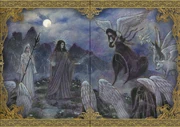
Angel-winged Messengers in Cosmogony.
The Messengers are magical beings sent by Astrals—the gods of Eos—to help the Oracle and make the gods' will known to mankind through her. Angels are non-physical entities or spirits found in various religions and mythologies. In Abrahamic religions and Zoroastrianism, angels are often depicted as benevolent celestial beings who act as intermediaries between God or Heaven and Earth, or as guardian spirits or a guiding influence. Their other roles include protecting and guiding humans, and carrying out God's tasks. In art, angels are often depicted with bird-like wings, a halo, robes and various forms of glowing light.
The Oracle in the prophecy painting is an angelic figure who has one wing. She also appears on the game's logo. The Oracle being depicted with one wing may refer to her origin as a mortal who wields divine power as a gift from the gods, as beings sent by the Astrals are depicted with two wings in Cosmogony.
There is also an island called Angelgard.
Lucis and Insomnia[]
The lands of Lucis likely hearken to many places as told within Christianity and Buddhism, specifically to places heralded as significant and prosperous. Lucis derives its environmental and economic basis from the tales of the Fisher King. The Fisher King was the last in the line of sworn rulers dedicated to protecting the Holy Grail, a divine vessel said to have miraculous powers, and was related to Jesus Christ. The Fisher King participated with guests in fishing through his realm, as he awaited the coming of a figure who would reverse the curse that threatened to turn his kingdom into a wasteland.
From a Buddhist perspective, it is believed that the karma of a founder ultimately determines how their endeavor grows and progresses, and even ends. Within Asian mythology, the northeastern direction is considered a cardinal direction capable of both good and evil. While the Bagua within certain schools of feng shui and onmyodo have the area of Heaven located in its northeastern compass, it is also believed that disease and demonic activity rides from the winds and stems from that direction.
Niflheim[]

A Niflheim flag.
Another example of dualism, Niflheim likely hearkens to places opposite of the heavenly and safe as portrayed by Lucis: hellish, unsafe, and threatening to those that do not follow its rules and ways. Likely in opposites to the examples portrayed by the Christian and Buddhist undertones that Lucis displays, Niflheim likely refers to places of "pagan" and unruly religious aspects, including Nordic religion, the synchronic rule of church and state, and the worst of atheism. While Norse religion is dignified and a proud tradition, its history entails ritual sacrifice that was a widely practiced trait of the Vikings to ensure their victories blessed by Odin and the Aesir.
The end of the world[]
The last parts of the game have elements significant to the interpretations of the "end of days" or the end of the world, be it the Christian Book of Revelation, otherwise known as the Armageddon, or that of Mappo or Kali Yuga, the Latter Days of the Dharma.
Lack of hand-to-hand combat[]
The world of Final Fantasy XV is one of the few installments, and the only installment of the main series, to not feature explicit hand-to-hand combat or knuckle weaponry, be it rooted in reality or the fantastical. This may hearken to times prior to the coming of such messianic figures like Jesus Christ and Buddha, as it is believed that their messages of mercy and justified force, as well as being figures of spiritual integrity and internal self development, inspired unarmed martial arts as a result.
The lack of direct magical options may also tie into the backgrounds of such messianic figures. Buddha refused the use of the miraculous powers that attaining Buddhahood allowed due to understanding the skeptical mind and how miracles could be abused selfishly over clearing the way to enlightenment and teaching others virtue. Many of the powers attained through enlightenment were strictly regulated to himself and to help further the realization of the truth. Jesus's miracles were done to alleviate the ills of the people rather than to be revered as the Messiah. Though he had command over the forces of heaven, Jesus refused out of the peace of the public to have them directly intervene.
References[]
- ↑ FINAL FANTASY XV EPISODE ARDYN PROLOGUE Q&A (7:52) (Accessed: January 22, 2025
 ) by FINAL FANTASY XV at YouTube
) by FINAL FANTASY XV at YouTube
